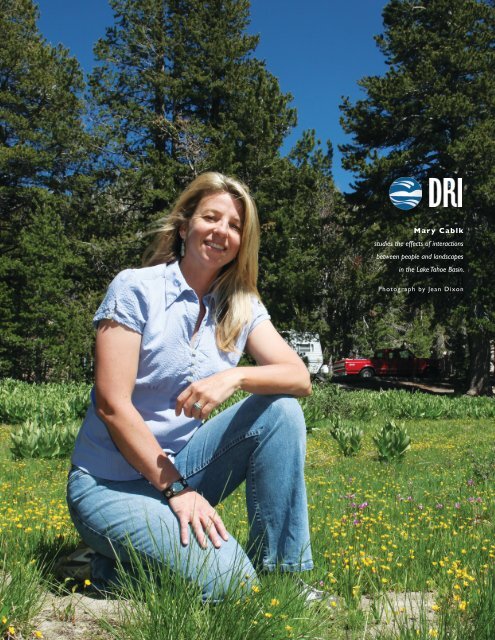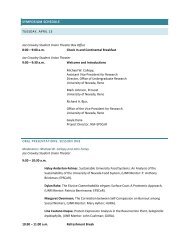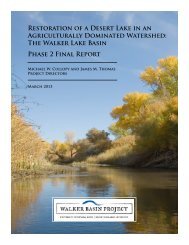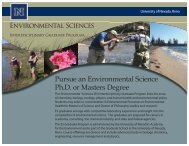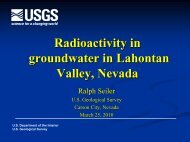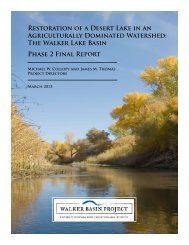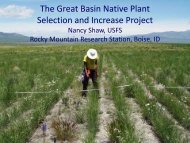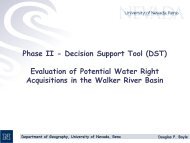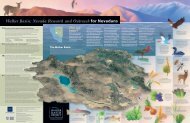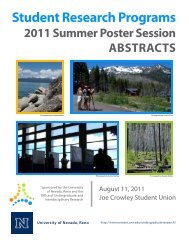Mary E. Cablk
Mary E. Cablk
Mary E. Cablk
You also want an ePaper? Increase the reach of your titles
YUMPU automatically turns print PDFs into web optimized ePapers that Google loves.
<strong>Mary</strong> <strong>Cablk</strong><br />
studies the effects of interactions<br />
between people and landscapes<br />
in the Lake Tahoe Basin.<br />
Photograph by Jean Dixon
<strong>Mary</strong> <strong>Cablk</strong><br />
Working extensively in the small details, remote sensing<br />
researcher does so with bigger philosophies in mind<br />
By Guia Del Prado<br />
Photographs by Peter Goin<br />
DRI<br />
www.dri.edu<br />
<strong>Mary</strong> <strong>Cablk</strong>, associate research professor<br />
at DRI, works extensively in the small<br />
details, but she does so with bigger<br />
philosophies in mind.<br />
“When it comes to landscapes, I think that<br />
there has to be a balance,” <strong>Cablk</strong> said of Lake<br />
Tahoe. “There are places that have to be allowed to<br />
remain difficult to get to. There are many examples<br />
around the world of what happens when people<br />
aren’t conscious of human impact.”<br />
This train of thought is present through all of<br />
<strong>Cablk</strong>’s work in Lake Tahoe. Though her research<br />
background is in the fields of ecology and remote<br />
sensing, her primary focus at Lake Tahoe can be<br />
summarized as studying the effects of interactions<br />
between people and landscapes.<br />
<strong>Cablk</strong> has studied the effects of skiers and<br />
human recreation on behavior patterns of the<br />
American martens in Heavenly Ski Resort’s leased<br />
land. The project was led by <strong>Cablk</strong> but was also a<br />
collaborative effort among DRI, the ski resort, and<br />
the U.S. Forest Service (USFS) Lake Tahoe Basin<br />
Management Unit.<br />
“The ski areas … are required to comply with<br />
a variety of environmental regulations in the Lake<br />
Tahoe Basin,” <strong>Cablk</strong> said. “The American marten<br />
is one USFS species of concern within the Tahoe<br />
Basin. The project addressed basic questions about<br />
how the marten at Heavenly react to the presence<br />
of skiers in terms of their use of the landscape<br />
throughout the year relative to how marten<br />
elsewhere use non-ski area landscapes. One of<br />
the questions asked was ‘Did the marten change<br />
their activity patterns relative to ski area activity<br />
patterns’ That is very much about people in the<br />
landscape.”<br />
And though many scientists focus on studying<br />
the lake itself, <strong>Cablk</strong> emphasizes the importance of<br />
studying the terrestrial area surrounding the lake.<br />
“The majority of research to date has focused<br />
on the lake itself,” she said. “But you cannot<br />
decouple the lake from the surrounding terrestrial<br />
environment. They are connected.”<br />
Another recent project was a historical changedetection<br />
study of the patterns of development<br />
in the South Lake Tahoe area. Through the use of<br />
aerial photographs and satellite imagery, <strong>Cablk</strong> and<br />
her colleagues at the U.S. Geological Survey studied<br />
changes in urban development, vegetation and<br />
land management policy for a 62-year time period<br />
between 1940 and 2002.<br />
“Although we mapped changes in development,<br />
the project’s focus was less on the urbanization<br />
itself than on changes on the surrounding forest,”<br />
<strong>Cablk</strong> said. “One thing we were able to show is<br />
that the effects of management practices, such<br />
as fire suppression, appear over time in the<br />
landscape’s patterns. We documented that as the<br />
number of people, more specifically development,<br />
increased over time from 1940 in South Lake<br />
Tahoe, there was a significant increase in tree<br />
canopy. Forest stands became dense. We realized<br />
that a catastrophic fire was highly likely in the area<br />
we examined–and shortly after we completed our<br />
study the Angora Fire occurred. The story of the<br />
Lake Tahoe Basin is complex but history provides<br />
insight about how things came to be.”<br />
<strong>Cablk</strong> also collaborated with fellow DRI<br />
scientist Tim Minor on mapping the entire Tahoe<br />
Basin’s hard impervious cover. These areas are<br />
man-made surfaces such as asphalt, buildings, metal<br />
or concrete that water cannot penetrate and<br />
instead runs over.<br />
“Again think about the terrestrial environment<br />
and what happens when the snow melt runs off or<br />
the rain hits asphalt,” <strong>Cablk</strong> said. “The water runs<br />
off and carries with it all the contaminants—think<br />
motor oil, gasoline, antifreeze—and the paved<br />
surfaces channel the contaminant-laden water right<br />
into the lake.”<br />
Though <strong>Cablk</strong> said she doesn’t have a deep<br />
personal connection to Lake Tahoe, her work there<br />
reflects a philosophy in protecting all environments<br />
from possible detrimental effects.<br />
“Although all landscapes are resilient, they are<br />
only so to a certain extent,” <strong>Cablk</strong> said.<br />
http://environment.unr.edu/tahoe


